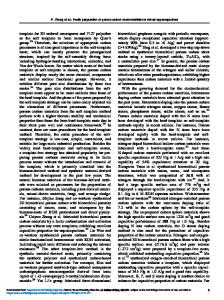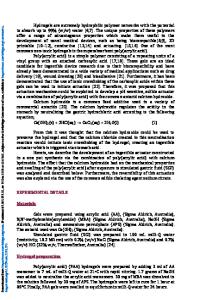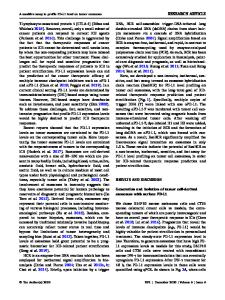Facile preparation of novel Pd nanowire networks on a polyaniline hydrogel for sensitive determination of glucose
- PDF / 3,090,295 Bytes
- 10 Pages / 595.276 x 790.866 pts Page_size
- 80 Downloads / 429 Views
RESEARCH PAPER
Facile preparation of novel Pd nanowire networks on a polyaniline hydrogel for sensitive determination of glucose Zhi Li 1 & Weina Qian 2 & Hui Guo 1 & Xiao Song 1 & Hao Yan 1 & Ruyi Jin 1 & Jianbin Zheng 3 Received: 21 February 2020 / Revised: 15 June 2020 / Accepted: 14 July 2020 # Springer-Verlag GmbH Germany, part of Springer Nature 2020
Abstract In this study, novel Pd nanowire networks (PdNW) grown on three-dimensional polyaniline hydrogel (3D-PANI) were prepared via a facile one-step electrodeposition approach at a constant potential of − 0.2 V and further utilized as an electrochemical sensing material for sensitive determination of glucose in alkaline medium. Compared with the sensor based on Pd nanofilm (PdNF)/3D-PANI prepared by electrodeposition at − 0.9 V, the sensor based on PdNW/3D-PANI presented substantially enhanced electrocatalytic activity towards glucose oxidation, with an excellent sensitivity of 146.6 μA mM−1 cm−2, a linear range from 5.0 to 9800 μM, and a low detection limit of 0.7 μM and was, therefore, demonstrated to be available for the determination of glucose in human serum. These findings are likely attributed to the combination of advantages of both PdNW and 3D-PANI, which outperformed most other Pd-based non-enzymatic glucose sensors reported earlier. Moreover, this non-enzymatic electrochemical sensor based on PdNW/3D-PANI may serve as an alternative tool for the assay of glucose and possibly other biomolecules. Keywords Nanowire networks . Polyaniline hydrogel . Modified electrode . Electrochemical sensor . Glucose
Introduction The method for quantitative and fast detection of glucose has been a subject of concern for decades in many areas, including the food industry, biotechnology, and clinical diagnostics [1]. Although several methods have been established for glucose detection, electrochemical sensors still have been emphasized due to their excellent detection performance, low cost, and simple instrumentation [2]. Generally, electrochemical sensor based on the immobilization of glucose oxidase displays high
* Weina Qian [email protected] * Jianbin Zheng [email protected] 1
College of Pharmacy, Shaanxi Key Laboratory Basic & New Herbal Medicament Research, Shaanxi University of Chinese Medicine, Xianyang 712046, Shaanxi, China
2
The Affiliated Hospital of Shaanxi University of Chinese Medicine, Xianyang 712000, Shaanxi, China
3
College of Chemistry and Materials Science, Institute of Analytical Science, Shaanxi Provincial Key Laboratory of Electroanalytical Chemistry, Northwest University, Xi’an 710069, Shaanxi, China
selectivity as well as sensitivity because of the specificity of the enzyme. Unfortunately, some inevitable drawbacks of the enzymatic sensor, including the high cost of enzymes, poor stability, as well as unsatisfactory reproducibility, derive from the nature of enzymes could inhibit their practical applications [3, 4]. Conversely, the non-enzymatic electrochemical glucose sensor—the direct electrocatalytic oxidation of glucose at the
Data Loading...











